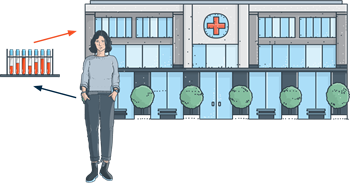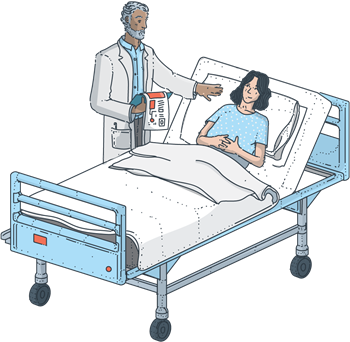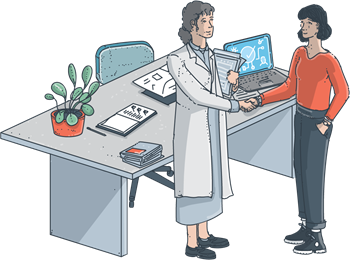
Key steps in the gene therapy treatment process
The treatment process for gene therapy will rely on close collaboration between the primary physician, the treatment team, the patient, and their caregivers. The path to treatment and treatment decisions are unique to every patient and every gene therapy. For example, some gene therapies are personalized, using the patient’s own cells as the basis for gene therapy. That said, we can review 4 main steps of the treatment process for many gene therapies. Each step in the treatment process can take place over weeks or even months, depending on a number of factors such as the disease being treated, the patient's health, travel, and time spent at the treatment center.
- Discuss risks and benefits of different treatment options, which may include gene therapy
- If a patient decides to discuss or move forward with a treatment option, they will need to go through a process called informed consent. Informed consent is where a patient actively participates in discussion with their physician and is empowered to make decisions about their medical care by deciding which treatments they do (or do not) want.
- Ensure appropriateness and eligibility of gene therapy
- Discuss any short- and long-term steps to plan for gene therapy
- May include discussions of chemotherapy, fertility preservation, side effects of treatment, and other considerations such as insurance coverage and cost of gene therapy

STEP 1: CONSULTATION (may include multiple visits over time)
- Discuss risks and benefits of different treatment options, which may include gene therapy
- If a patient decides to discuss or move forward with a treatment option, they will need to go through a process called informed consent. Informed consent is where a patient actively participates in discussion with their physician and is empowered to make decisions about their medical care by deciding which treatments they do (or do not) want.
- Ensure appropriateness and eligibility of gene therapy
- Discuss any short- and long-term steps to plan for gene therapy
- May include discussions of chemotherapy, fertility preservation, side effects of treatment, and other considerations such as insurance coverage and cost of gene therapy
As with any treatment decision, the patient, their caregivers, and their primary physician will discuss the risks and benefits of different treatment options available to them, which may include gene therapy. If the person decides they are interested in learning more, their primary physician may schedule a consultation at a treatment center. This treatment center may be a specialized hospital with staff who are focused and trained in administering gene therapy (this could be different from the patient’s primary hospital). The patient’s primary physician and care team at the treatment center work with the patient to collectively determine if gene therapy is the appropriate treatment choice for them.

STEP 2: PREPARATION
- Will include all cell collection for ex vivo gene therapy treatments
- Includes the drug maker manufacturing any personalized gene therapy
- Physician will give instructions for any preparation procedures or regimens that the patient will need to complete
Once the patient and their physicians agree that they want to pursue gene therapy, preparations for treatment will begin.
- For patients undergoing in vivoIn vivoinside the body
See glossary for more terms > gene therapy, conditioning with oral steroids or other medications may be necessary for a certain time period before treatment - For patients undergoing ex vivoEx vivooutside the body
See glossary for more terms > gene therapy, cells must be collected and then genetically modified before treatment can begin

STEP 3: TREATMENT
- May be an inpatient procedure
- Conditioning with chemotherapy may be a part of this stage
- Gene therapy treatment is often administered by a specialist and can include a specialized care team
The treatment team will administer gene therapy to the person in a controlled and protected environment. Depending on the type of gene therapy, this may involve conditioningConditioningthe process where a patient is prepared to receive transplanted donor cells through chemotherapy, radiotherapy, and/or immunotherapy
See glossary for more terms >, or regimens to help maximize the effects of treatment.
See glossary for more terms >, or regimens to help maximize the effects of treatment.
- For patients undergoing in vivo gene therapy, they will receive gene therapy after they have completed any preparation ahead of time. They may receive their treatment as an injection or infusion in their bloodstream or in a target tissue or organ.
- For patients undergoing ex vivo gene therapy, the cells collected in the “preparation” step will be delivered to a specialized laboratory and manufacturing center. Each ex vivo gene therapy is created specifically for the patient, as it is a personalized treatment that is made from their own cells. These cells are genetically modified in a highly regulated process to help maintain the quality of the gene therapy. The gene therapy will go through many tests and checks before it is sent to the treatment center. Those who undergo ex vivo HSC gene therapy will complete a chemotherapy conditioning regimen right before receiving treatment to clear space for engraftmentEngraftmentENGRAFTMENT DEFINITION GOES HERE
See glossary for more terms > of the modified cells. - Each gene therapy is different. So, it's important patients talk to their doctors about any specific questions or concerns related to their treatment.

STEP 4: RECOVERY/FOLLOW-UP
- Patient will be discharged from treatment facility after physician consultation and a recovery period
- May include follow-up appointments
- May include home healthcare for a period of time
- May include enrolling in a registry to monitor long-term treatment results
After gene therapy is administered, there is a critical process of recovery and a follow-up period that can last for a number of years. The patient will work with their primary physician and treatment team to monitor safety and effectiveness of gene therapy in the period immediately after treatment. Patients treated with gene therapy will also work with their physicians to monitor the effect of treatment for the long term, which may be several years. As gene therapies continue to be studied for different genetic diseases, patients may be enrolled in registries to help track the long-term outcomes of treatment.
Data collected as part of these registries may include:
Data collected as part of these registries may include:
- Patient demographics
- Long-term safety
- Long-term effectiveness of treatment
- Quality-of-life measures
- Healthcare utilization
Explore Genehome
Want to learn about how gene therapies are made?
Explore Genehome
Want to learn about how gene therapies are made?
Genetics and Gene Therapy in Action
Watch the steps of ex vivo gene addition therapy
Other topics you may be interested in:

Keep learning with Genehome
Expand your knowledge with gene therapy and content sent directly to your inbox.
